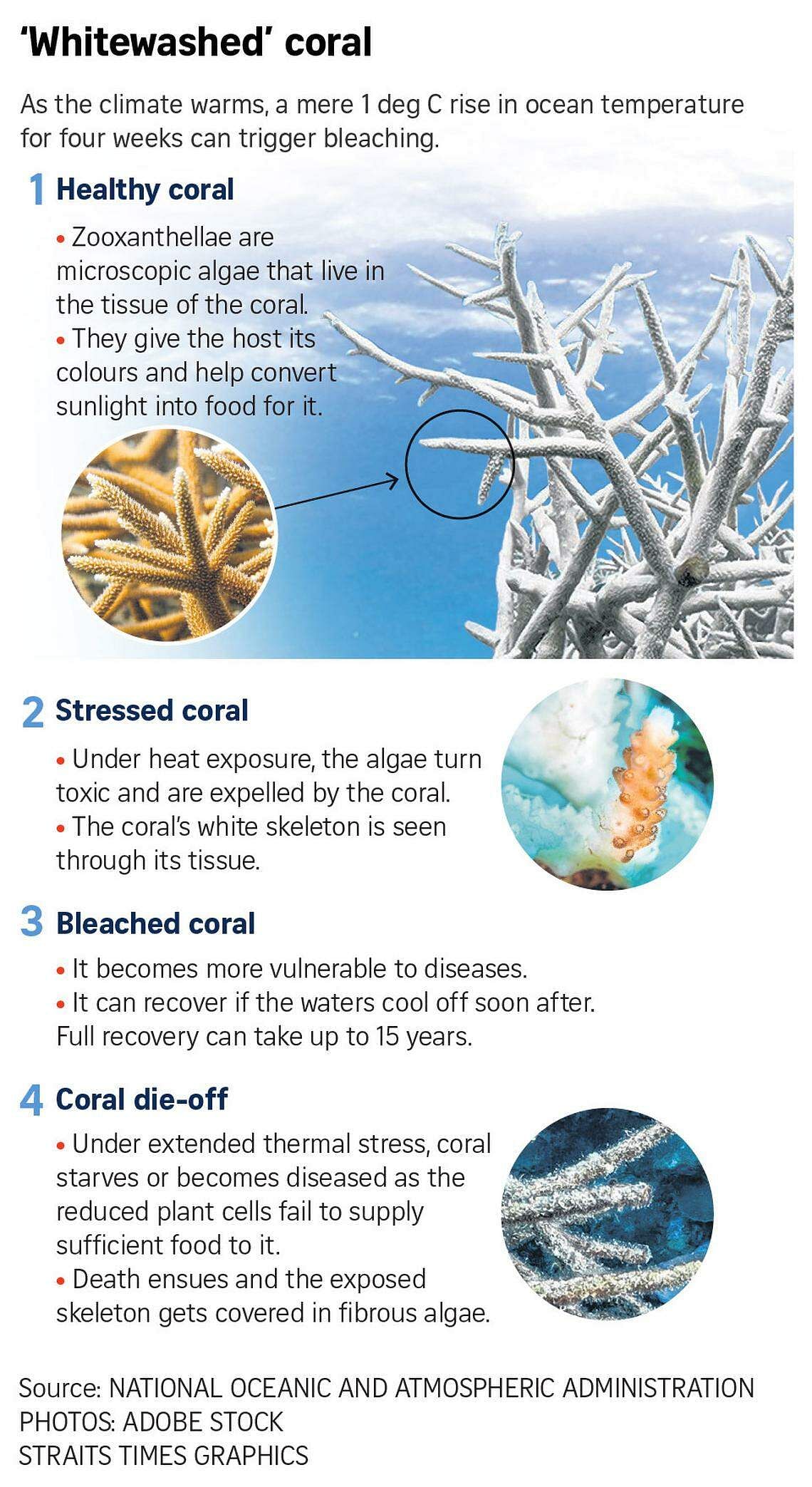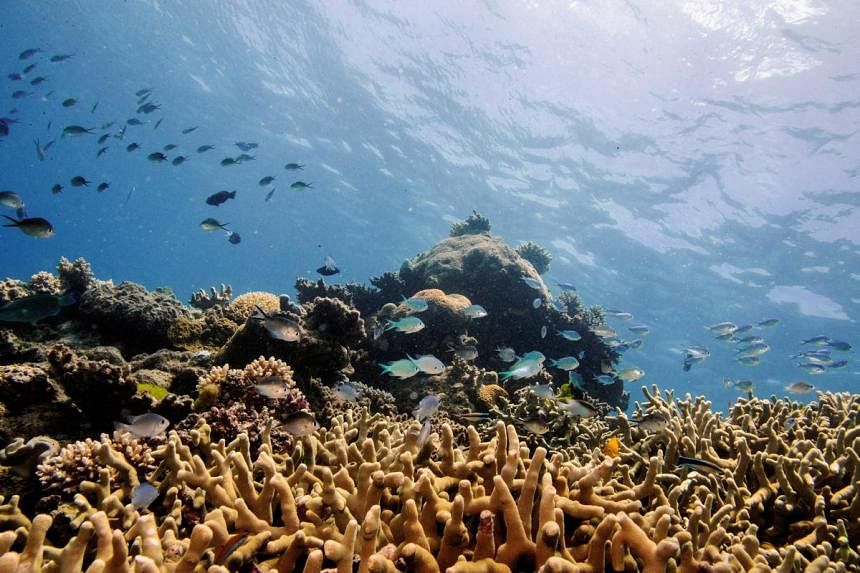SYDNEY – Australia’s Great Barrier Reef, the world’s largest living structure and a huge tourist drawcard, is suffering widespread bleaching after weeks of abnormally high sea temperatures, with fears of widespread coral deaths.
The event is the seventh bleaching episode since 1998 – and the fifth in just eight years – and is likely to lead to the widespread death of heat-sensitive corals, which typically need a decade or more to recover from such events.
Most of the reef is now affected, scientists say, further threatening the future of one of nature’s greatest showcases of biodiversity, which attracts millions of people every year and generates billions of dollars in economic value.
A key measure of bleaching risk is the accumulated heat stress corals face, meaning the number of weeks they are exposed to above average temperatures. The longer the exposure and the hotter the water, the greater the risk of bleaching and death of corals.
“This is already a major event, larger in extent than any other, with accumulated heat stress that will next week exceed all earlier bleaching events,” said leading reef scientist Terry Hughes from James Cook University in Townsville, Queensland.
Aerial surveys spanning two-thirds of the marine park confirm that a widespread coral bleaching event is under way along the 2,300km reef, the Great Barrier Reef Marine Park Authority said on March 8. The warning signs have been flashing for weeks. Satellite readings have shown abnormally high sea-surface temperatures along the southern, central and northern portions of the reef this summer. The southern section is the most affected, with current temperatures of around 28.1 deg C, about 1.8 deg C above normal.
“The results are consistent with what we have seen with above average sea-surface temperatures across the marine park for an extended period of time,” said Dr Roger Beeden, chief scientist at the Reef Authority, the government agency managing the reef.
The surveys looked mainly at the inshore, midshore and shallow offshore reefs. More surveys need to be done to assess the severity of bleaching on deeper water parts of the reef, the authority said.
The Great Barrier Reef is built by hundreds of different coral species, many of which are sensitive to small increases in sea temperature. Because of climate change, summer water temperatures and extreme marine heatwaves have been increasing, and the corals have struggled to adapt.
When stressed by prolonged exposure to abnormally high water temperatures, corals expel the photosynthetic algae that both give them their colour and provide them with food.
Corals can recover if water temperatures quickly return to normal after a few weeks. But prolonged exposure over many weeks makes this less likely, and this can lead to widespread death of some coral species.

Loss of the coral reef habitat can lead to the extinction of certain marine species and disrupt fisheries, while reef degradation means that shorelines have less of a buffer against waves, storms and floods.
During back-to-back bleaching events in 2016 and 2017, up to half of all shallow water corals in the northern and central sections died.
“Climate change is the greatest threat to the Great Barrier Reef, and coral reefs globally,” Dr Beeden said.
The bleaching is the latest to occur globally over the past year, with widespread coral deaths in Florida and the Caribbean in 2023.
The United States’ National Oceanic and Atmospheric Administration (NOAA) said the world is on the verge of a fourth mass coral bleaching event affecting vast stretches of tropical reefs, including the Great Barrier Reef, according to a Reuters report on March 5.
Corals in the waters around Singapore currently show no heat stress, but the NOAA’s Coral Reef Watch site shows swathes of the world’s tropical ocean belt facing elevated sea-surface temperatures.
More frequent bleaching events underscore the pressing urgency of the challenges faced by the Great Barrier Reef.

Noting the bleaching events in 2016, 2017, 2020, 2022 and now in 2024, Professor Hughes said: “In each event, different regions of the reef have escaped bleaching, or bleached very badly, depending on where the water was hottest for the longest.
“2024 is unusual because unlike other years, no region is cool. The south reached dangerous temperatures earlier in the summer, but the northern and to a lesser extent the central regions are now also very hot,” added the Federation Fellow at the ARC Centre for Excellence for Coral Reef Studies at James Cook University.
“Corals are already dying in the northern and southern regions. Stressful conditions will peak in the next week or two. The level of heat stress – where the water has been hottest for longest – is approaching record levels since satellite records began.”

Prof Hughes said the Great Barrier Reef is now a chequerboard of reefs with different recent histories of coral bleaching. Reefs that bleached in 2017 or 2016 have had just five to six years of partial recovery – if they escaped bleaching again in 2020 and 2022. “Ironically, the corals that are now prevalent on many reefs are young colonies of fast-growing heat-sensitive species of branching corals – analogous to the rapid recovery of flammable grasses after a forest fire.”
The Australian government has been criticised for failing to do enough to protect the reef from climate change, which is being driven by the burning of fossil fuels. Australia is a leading exporter of coal and gas, some of which is shipped through the reef.
“We know the biggest threat to coral reefs worldwide is climate change. The Great Barrier Reef is no exception,” Environment Minister Tanya Plibersek said. “We need to act on climate change.”
Greenpeace Australia Pacific chief executive David Ritter said: “Claims that Australia is taking the health of the Great Barrier Reef seriously ring hollow when we continue to expand and subsidise the coal and gas industry to the tune of billions every year.”
Australia has been lobbying for years to keep the reef – which contributes about A$6 billion (S$5.3 billion) to the economy and supports 64,000 jobs – off Unesco’s endangered list as it could lead to losing its heritage status, taking some shine off its attraction for tourists.



